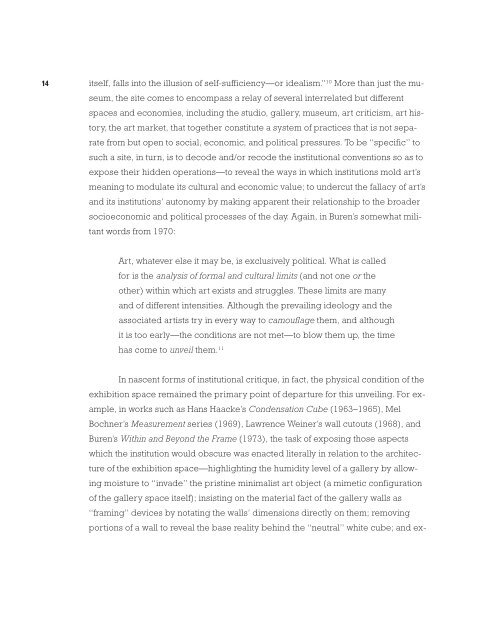ONE PLACE AFTER ANOTHER - Monoskop
ONE PLACE AFTER ANOTHER - Monoskop
ONE PLACE AFTER ANOTHER - Monoskop
You also want an ePaper? Increase the reach of your titles
YUMPU automatically turns print PDFs into web optimized ePapers that Google loves.
14<br />
itself, falls into the illusion of self-sufficiency—or idealism.” 10 More than just the mu-<br />
seum, the site comes to encompass a relay of several interrelated but different<br />
spaces and economies, including the studio, gallery, museum, art criticism, art history,<br />
the art market, that together constitute a system of practices that is not separate<br />
from but open to social, economic, and political pressures. To be “specific” to<br />
such a site, in turn, is to decode and/or recode the institutional conventions so as to<br />
expose their hidden operations—to reveal the ways in which institutions mold art’s<br />
meaning to modulate its cultural and economic value; to undercut the fallacy of art’s<br />
and its institutions’ autonomy by making apparent their relationship to the broader<br />
socioeconomic and political processes of the day. Again, in Buren’s somewhat militant<br />
words from 1970:<br />
Art, whatever else it may be, is exclusively political. What is called<br />
for is the analysis of formal and cultural limits (and not one or the<br />
other) within which art exists and struggles. These limits are many<br />
and of different intensities. Although the prevailing ideology and the<br />
associated artists try in every way to camouflage them, and although<br />
it is too early—the conditions are not met—to blow them up, the time<br />
has come to unveil them. 11<br />
In nascent forms of institutional critique, in fact, the physical condition of the<br />
exhibition space remained the primary point of departure for this unveiling. For example,<br />
in works such as Hans Haacke’s Condensation Cube (1963–1965), Mel<br />
Bochner’s Measurement series (1969), Lawrence Weiner’s wall cutouts (1968), and<br />
Buren’s Within and Beyond the Frame (1973), the task of exposing those aspects<br />
which the institution would obscure was enacted literally in relation to the architecture<br />
of the exhibition space—highlighting the humidity level of a gallery by allowing<br />
moisture to “invade” the pristine minimalist art object (a mimetic configuration<br />
of the gallery space itself); insisting on the material fact of the gallery walls as<br />
“framing” devices by notating the walls’ dimensions directly on them; removing<br />
portions of a wall to reveal the base reality behind the “neutral” white cube; and ex-

















